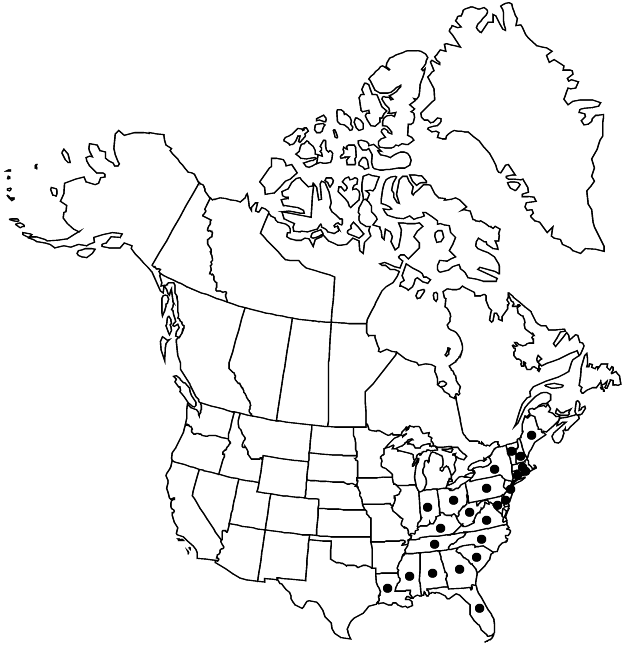Difference between revisions of "Kalmia latifolia"
Sp. Pl. 1: 391. 1753 ,.
FNA>Volume Importer |
imported>Volume Importer |
||
| (3 intermediate revisions by 2 users not shown) | |||
| Line 7: | Line 7: | ||
}} | }} | ||
|common_names=Mountain laurel | |common_names=Mountain laurel | ||
| + | |special_status={{Treatment/ID/Special_status | ||
| + | |code=E | ||
| + | |label=Endemic | ||
| + | }} | ||
|basionyms= | |basionyms= | ||
|synonyms={{Treatment/ID/Synonym | |synonyms={{Treatment/ID/Synonym | ||
|name=Chamaedaphne latifolia | |name=Chamaedaphne latifolia | ||
|authority=(Linnaeus) Kuntze | |authority=(Linnaeus) Kuntze | ||
| + | |rank=species | ||
}} {{Treatment/ID/Synonym | }} {{Treatment/ID/Synonym | ||
|name=Kalmia latifolia var. laevipes | |name=Kalmia latifolia var. laevipes | ||
|authority=Fernald | |authority=Fernald | ||
| + | |rank=variety | ||
}} | }} | ||
|hierarchy=Ericaceae;Ericaceae subfam. Ericoideae;Kalmia;Kalmia latifolia | |hierarchy=Ericaceae;Ericaceae subfam. Ericoideae;Kalmia;Kalmia latifolia | ||
| Line 41: | Line 47: | ||
-->{{#Taxon: | -->{{#Taxon: | ||
name=Kalmia latifolia | name=Kalmia latifolia | ||
| − | |||
|authority=Linnaeus | |authority=Linnaeus | ||
|rank=species | |rank=species | ||
| Line 55: | Line 60: | ||
|publication title=Sp. Pl. | |publication title=Sp. Pl. | ||
|publication year= | |publication year= | ||
| − | |special status= | + | |special status=Endemic |
| − | |source xml=https:// | + | |source xml=https://bitbucket.org/aafc-mbb/fna-data-curation/src/2e0870ddd59836b60bcf96646a41e87ea5a5943a/coarse_grained_fna_xml/V8/V8_939.xml |
|subfamily=Ericaceae subfam. Ericoideae | |subfamily=Ericaceae subfam. Ericoideae | ||
|genus=Kalmia | |genus=Kalmia | ||
Latest revision as of 22:47, 5 November 2020
Shrubs or, rarely, trees, erect, (1–)2–8(–12) m. Twigs terete, viscid, stipitate-glandular, glabrescent. Leaves alternate (seemingly whorled on slow-growing twigs); petiole 10–30 mm, glabrous or puberulent, sometimes stipitate-glandular; blade elliptic to elliptic-lanceolate, 4–12 × 1.5–5 cm, margins plane, apex acute, surfaces stipitate-glandular, glabrescent abaxially, glabrous, midrib puberulent adaxially. Inflorescences terminal, panicles, (12–)20–40-flowered. Pedicels 20–40 mm. Flowers: sepals green to reddish, usually oblong, 3–3.5 mm, apex acute, surfaces glabrous or stipitate-glandular; petals connate nearly their entire lengths, usually pink (ranging from deep red to white) with purple spots around each anther pocket, 20–25 × 15–30 mm, abaxial surface usually lightly stipitate-glandular, adaxial puberulent; filaments 4–5 mm; style 10–18 mm. Capsules 5-locular, 3–5 × 4–7 mm, stipitate-glandular. Seeds winged, obovoid and curved, 0.5–1 mm. 2n = 24.
Phenology: Flowering Apr–Jun.
Habitat: Rocky or sandy hardwood forests on mountain slopes, stream bluffs, ravines, or in pure, dense thickets
Elevation: 0-1900 m
Distribution

Ala., Conn., Del., Fla., Ga., Ind., Ky., La., Maine, Md., Mass., Miss., N.H., N.J., N.Y., N.C., Ohio, Pa., R.I., S.C., Tenn., Vt., Va., W.Va., introduced in Europe (England).
Discussion
Kalmia latifolia is a showy and beautiful American indigenous plant. E. S. Rand (1871) wrote that “no words can describe the beauty of this plant on the mountains of the Middle States, where it covers acres, and sheets whole hillsides with pink and white.”